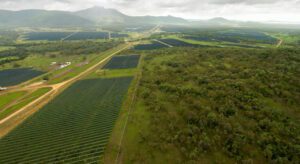Here’s a couple of interesting graphs that come from Energex, the network operator in the south-east corner of Queensland, which is dealing with the highest penetration of rooftop solar systems in Australia, with the possible exception of Adelaide and surrounding areas.
This first graph shows a remarkable jump in the efficiency of solar PV systems in south east Queensland in the last six months. The blue line represents the amount of electricity per kilowatt of installed capacity fed back into the grid from solar systems operating under the now defunct 46c/kWh feed in tariff, while the red line represents the amount under the new 8c/kWh FiT.
The fact that the blue line is higher than the red line should not surprise, because there is a greater incentive to export with the former tariff, and a great incentive to self-consume the electricity produced from the solar system under the new tariff. In fact, one wonders why the red line has increased at all.
However, there may be other reasons cited by Energex boffins.
These include the fact that solar PV systems are generally better designed and are better installed, there are more panels per inverter. Some 5Kw rated systems (with a 7Kw inverter) are pro ducting more than 40Kwh/day. The other potential factors are that households are becoming more aware of prices and energy efficiency, and possibly because this has been a relatively sunny year.
This next graph is interesting because it gives the recent history of solar installations under the two schemes. Unsurprisingly, the number of systems under the 46x/kWh FiT is falling fast as the scheme winds down, and the last of those who managed to get approval finally get to install the system.
What is interesting, and promising for the solar industry, is the number of systems being built under the 8c/kWh tariff. It has enjoyed a couple of peaks of nearly 4,000 systems a month, but has been solid and not fallen below 2,000 systems a month since late last year.
graph










